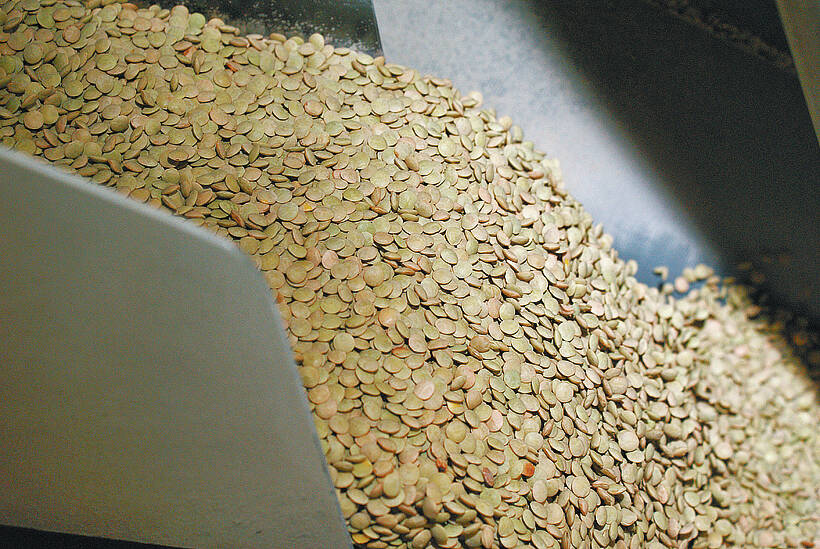This cattle market information is selected from the weekly report from Canfax, a division of the Canadian Cattlemen’s Association. More market information, analysis and statistics are available by becoming a Canfax subscriber by calling 403-275-5110 or at www.canfax.ca.
Dressed sales steady
Alberta direct cattle sales saw light dressed trade last week, with buying interest reported from both sides of the border. Local dressed sales were fully steady with the previous week from $304-$305 per hundredweight delivered.
Read Also

Green lentil market oversupplied
Farmers in Western Canada can expect price pressure on their new crop of green lentils, as the available supplies among the world’s major lentil-growing nations increase significantly.
Trade volumes were limited, but U.S. bids of US$236 per cwt. delivered procured a significant portion of the cash trade at a $7 per cwt. live equivalent premium to local bids.
Weighted average steer prices firmed around $2.50 per cwt. higher than the previous week to $185.50 per cwt. Thin heifer trade saw prices generally comparable with steers, but trade activity was once again too slight to establish a weekly price trend.
Western Canadian fed slaughter for the week ending Dec. 3 rebounded three percent larger than the previous week to 44,025 head, and year-to-date slaughter was fully steady at 2,083,492 head.
Western fed cattle/cow exports to the United States for the week ending Nov. 26 were 53 percent larger than the same week last year at 11,907 head, and year-to-date fed cattle/cow exports were up 10 percent to 444,438 head.
Most Ontario trade last week was reported steady with the previous week at $320 per cwt. delivered.
Uncertain beef demand for the first quarter of 2023 and ample beef in cold storage are expected to moderate fed harvests for the rest of December. Packers are well bought with inventories stretched to the second half of January, and market-ready feedlot supplies are trending less current.
In the U.S., light live trade was generally steady with the previous week from US$154-$156 per cwt. in the south and $156-$158 per cwt. in the north. Thin northern dressed trade was $2-$3 per cwt. lower than the previous week’s Nebraska rail average, with most sales reported from $246-$248 per cwt. delivered.
Cow price in doldrums
Cow prices have dropped 29 percent from their highs in August. From annual highs to fall lows, this stands as the third largest decline over the past 10 years. The only years to see a larger decline were 2015 (33 percent) and 2021 (41 percent).
Cow prices have trended lower in seven of the past eight weeks, but the market is showing signs of stability. Last week D2s averaged $82.08 and D3s averaged $70.33 per cwt.
On a cash-to-cash basis, Alberta cow prices are trading at a $16 per cwt. discount to the U.S., one of the largest discounts Alberta cow prices have been to the U.S. all year.
For the week ending Dec. 3, western Canadian cow slaughter totalled slightly more than 9,900 head, the largest weekly slaughter since February 2020. Non-fed volumes through commercial auction facilities have started to moderate, suggesting peak slaughter volumes are behind us.
Ontario cow prices have averaged in the mid-$90s per cwt. for the past five weeks. For the beginning of December, this stands as the second highest price on record.
Feeders get boost
Trading $5 per cwt. higher last week, calf prices were at the highest point since late September, while heavier weight feeder prices hovered near fourth quarter lows. A few more preconditioned calves and feeders hit the market, and premiums were paid compared to freshly weaned calves/stockers.
Over the previous two weeks, Alberta 900 pound and heavier heifers have been trading par to a slight premium compared to 800-900 lb. heifers. Larger groups of preg-checked open replacement quality heifers are fetching a premium, resulting in no price slide between the two weight categories.
The forward delivery market was lightly tested with 850 lb. Saskatchewan heifers for March delivery trading in the low $220s. A few Alberta 900 lb. and heavier steers also traded for September delivery with prices in the upper $240s per cwt.
Since the second half of November, bred cow prices are around $50 per head higher on average, while bred heifer prices are $200 per head stronger. Herd dispersal cows and reputation bred heifers are generating good buying interest, while older cows continue to be a tough sell.
Last week, Alberta bred cows traded from $1,325-2,800 per head, averaging $1,775, while bred heifers were reported from $1,775-$2,950 per head, averaging $2,200.
U.S. cutouts soften
In U.S. beef trade, cutouts ended the week following seasonal trends. Choice cutouts softened 2.5 percent from last week to US$247.28 per cwt., and Select cutouts declined two percent to $220.55 per cwt.














